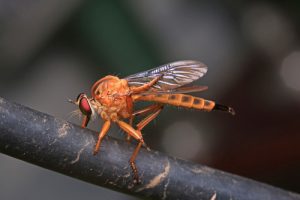Phorid Flies and Sewer Breaks
By Chris Williams on November 11, 2011.
Q. We’ve had an ongoing problem for about 4 months with little gnats. We see dozens at a time running across countertops and walls, mostly in the downstairs family room. I thought they were fruit flies but an extension agent said he thought they were phorid flies. We had a pest control company spray and the flies were gone for awhile but they soon came back. Can you give me any idea what they’re feeding on?
A. If your gnats are indeed phorid flies, they belong to the group of tiny flies that we like to call “wet gunk” gnats. This group also includes fruit flies, fungus gnats, and drain flies. The larvae of all of these flies feed on different kinds of organic goo, mostly decaying or fermenting materials.
Phorid flies are also called humpbacked flies because when you look at them from the side, you can see that their head is bent down under a large, humped thorax. They’re about 1/8-inch long and brown with light brown wings, and are attracted to lights. The larval stage is whitish, legless, and maggot-like. You won’t see the larvae unless you find the food source where they are feeding.
 Phorid flies can be found infesting some very disgusting sites like sewers and even morgues where they feed on corpses. They can be major pests in mausoleums, morgues, hospitals (where they feed on open wounds), and mushroom farms. Around homes though, the larvae are found in moist areas where they feed on a variety of things: decaying vegetation, sewage, gelatinous goo in clogged drains and dirty garbage cans, animal feces, and dead animals and insects. Unfortunately, ongoing infestations in homes are sometimes traced to broken septic or sewer lines.
Phorid flies can be found infesting some very disgusting sites like sewers and even morgues where they feed on corpses. They can be major pests in mausoleums, morgues, hospitals (where they feed on open wounds), and mushroom farms. Around homes though, the larvae are found in moist areas where they feed on a variety of things: decaying vegetation, sewage, gelatinous goo in clogged drains and dirty garbage cans, animal feces, and dead animals and insects. Unfortunately, ongoing infestations in homes are sometimes traced to broken septic or sewer lines.
When a sewer line breaks, perhaps from invading tree roots or settling ground, hundreds, even thousands, of pounds of waste can accumulate under a slab or crawl. This subsoil area is rarely solid. Instead, fluid from the broken pipe produces open spaces. Phorids can continue their life cycle totally underground, building up high populations before anyone realizes there’s a problem. But if adult flies find a route to light, perhaps through a crack in a slab or an open expansion joint, hundreds of flies per day can enter the building above. When a pest control company sprays inside your home, they will kill the flies that are there at the moment but new flies will continue to emerge from below ground. This may not be what’s going on in your case. Hopefully not, because resolving this kind of phorid fly infestation can be expensive. Often the contaminated soil has to be excavated, discarded, and replaced with clean soil to fully eliminate the infestation.
You need a thorough inspection of your home to determine precisely where the phorid flies are coming from. A trained technician should work through the simpler solutions first. If the source of the flies can’t be found and a sewer or septic break is suspected, a plumbing company with specialized equipment may have to be brought in. Plumbers can use special video inspection, smoke tests, or leak tests to find a break in the lines. Their cameras are threaded through the sewer lines and can even see phorid fly larvae and pupal cases in the soil.
One thing about serious phorid fly infestations is that they usually don’t go away by themselves. Unless the food source is found and removed, adult flies will continue to emerge. Call Colonial today. We can help.